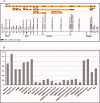Deletion at chromosome arm 9p in relation to BRAF/NRAS mutations and prognostic significance for primary melanoma
- PMID: 20140953
- PMCID: PMC2948432
- DOI: 10.1002/gcc.20753
Deletion at chromosome arm 9p in relation to BRAF/NRAS mutations and prognostic significance for primary melanoma
Abstract
We report an investigation of gene dosage at 9p21.3 and mutations in BRAF and NRAS, as predictors of relapse and histological markers of poor melanoma prognosis. Formalin-fixed primary melanomas from 74 relapsed and 42 nonrelapsed patients were sequenced for common BRAF and NRAS mutations (N = 71 results) and gene dosage at 9p21.3 including the genes CDKN2A (which encodes CDKN2A and P14ARF), CDKN2B (CDKN2B), and MTAP was measured using multiplexed ligation-dependant probe amplification (MLPA), (N = 75 results). BRAF/NRAS mutations were detected in 77% of relapsers and 58% of nonrelapsers (Fisher's exact P = 0.17), and did not predict ulceration or mitotic rate. There was no relationship between BRAF/NRAS mutations and gene dosage at 9p21.3. Reduced gene dosage at MTAP showed a borderline association with BRAF mutation (P = 0.04) and reduced gene dosage at the interferon gene cluster was borderline associated with wild type NRAS (P = 0.05). Reduced gene dosage in the CDKN2A regions coding for CDKN2A was associated with an increased risk of relapse (P = 0.03). Reduced gene dosage across 9p21.3 was associated with increased tumor thickness, mitotic rate, and ulceration (P = 0.02, 0.02, and 0.002, respectively), specifically in coding regions impacting on CDKN2B and P14ARF and CDKN2A. Loss at MTAP (P = 0.05) and the interferon gene cluster (P = 0.03) on 9p21 was also associated with tumor ulceration. There was no association between reduced gene dosage at 9p21.3 and subtype or site of tumor. This study presents supportive evidence that CDKN2B, P14ARF, and CDKN2A may all play a tumor suppressor role in melanoma progression.
(c) 2010 Wiley-Liss, Inc.
Figures




Similar articles
-
Fine-mapping loss of gene architecture at the CDKN2B (p15INK4b), CDKN2A (p14ARF, p16INK4a), and MTAP genes in head and neck squamous cell carcinoma.Arch Otolaryngol Head Neck Surg. 2006 Apr;132(4):409-15. doi: 10.1001/archotol.132.4.409. Arch Otolaryngol Head Neck Surg. 2006. PMID: 16618910
-
Expression of Chr9p21 genes CDKN2B (p15(INK4b)), CDKN2A (p16(INK4a), p14(ARF)) and MTAP in human atherosclerotic plaque.Atherosclerosis. 2011 Feb;214(2):264-70. doi: 10.1016/j.atherosclerosis.2010.06.029. Epub 2010 Jun 23. Atherosclerosis. 2011. PMID: 20637465
-
BRAF V600E mutation and 9p21: CDKN2A/B and MTAP co-deletions - Markers in the clinical stratification of pediatric gliomas.BMC Cancer. 2018 Dec 17;18(1):1259. doi: 10.1186/s12885-018-5120-0. BMC Cancer. 2018. PMID: 30558563 Free PMC article.
-
Virtually 100% of melanoma cell lines harbor alterations at the DNA level within CDKN2A, CDKN2B, or one of their downstream targets.Genes Chromosomes Cancer. 1998 Jun;22(2):157-63. doi: 10.1002/(sici)1098-2264(199806)22:2<157::aid-gcc11>3.0.co;2-n. Genes Chromosomes Cancer. 1998. PMID: 9598804 Review.
-
Familial cutaneous melanoma.Adv Exp Med Biol. 2010;685:134-45. doi: 10.1007/978-1-4419-6448-9_13. Adv Exp Med Biol. 2010. PMID: 20687502 Review.
Cited by
-
A primary melanoma and its asynchronous metastasis highlight the role of BRAF, CDKN2A, and TERT.J Cutan Pathol. 2015 Feb;42(2):108-17. doi: 10.1111/cup.12444. Epub 2014 Dec 11. J Cutan Pathol. 2015. PMID: 25407517 Free PMC article.
-
Molecular and Immune Biomarkers for Cutaneous Melanoma: Current Status and Future Prospects.Cancers (Basel). 2020 Nov 20;12(11):3456. doi: 10.3390/cancers12113456. Cancers (Basel). 2020. PMID: 33233603 Free PMC article. Review.
-
A microRNA profile of pediatric glioblastoma: The role of NUCKS1 upregulation.Mol Clin Oncol. 2019 Mar;10(3):331-338. doi: 10.3892/mco.2019.1795. Epub 2019 Jan 2. Mol Clin Oncol. 2019. PMID: 30847170 Free PMC article.
-
Novel Biomarkers and Druggable Targets in Advanced Melanoma.Cancers (Basel). 2021 Dec 24;14(1):81. doi: 10.3390/cancers14010081. Cancers (Basel). 2021. PMID: 35008245 Free PMC article. Review.
-
Oncogenic BRAF mutations and p16 expression in melanocytic nevi and melanoma in the Polish population.Postepy Dermatol Alergol. 2017 Oct;34(5):490-498. doi: 10.5114/ada.2017.71119. Epub 2017 Oct 31. Postepy Dermatol Alergol. 2017. PMID: 29507566 Free PMC article.
References
-
- Balch CM, Buzaid AC, Soong SJ, Atkins MB, Cascinelli N, Coit DG, Fleming ID, Gershenwald JE, Houghton A, Jr, Kirkwood JM, McMasters KM, Mihm MF, Morton DL, Reintgen DS, Ross MI, Sober A, Thompson JA, Thompson JF. Final version of the american joint committee on cancer staging system for cutaneous melanoma. J Clin Oncol. 2001;19:3635–3648. - PubMed
-
- Bishop DT, Demenais F, Goldstein AM, Bergman W, Bishop JN, Bressac-de Paillerets B, Chompret A, Ghiorzo P, Gruis N, Hansson J, Harland M, Hayward N, Holland EA, Mann GJ, Mantelli M, Nancarrow D, Platz A, Tucker MA. Geographical variation in the penetrance of CDKN2A mutations for melanoma. J Natl Cancer Inst. 2002;94:894–903. - PubMed
Publication types
MeSH terms
Substances
Grants and funding
LinkOut - more resources
Full Text Sources
Medical
Research Materials
Miscellaneous

